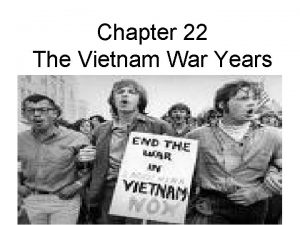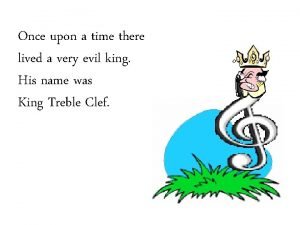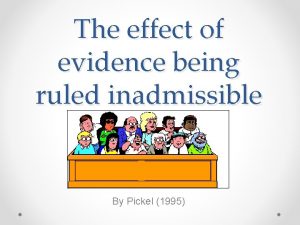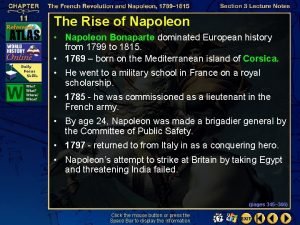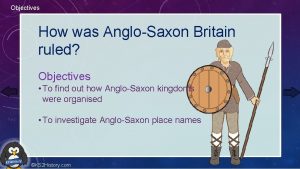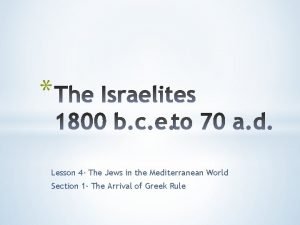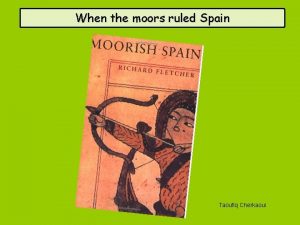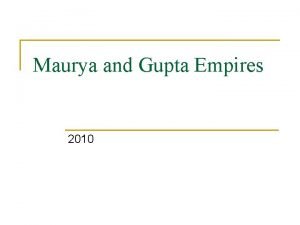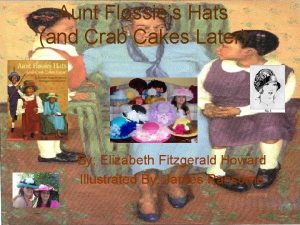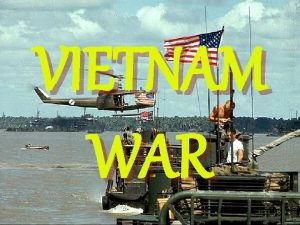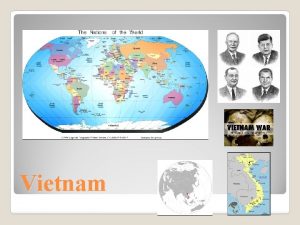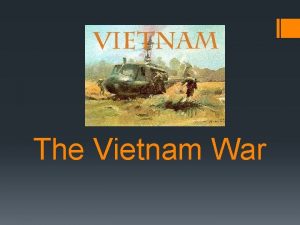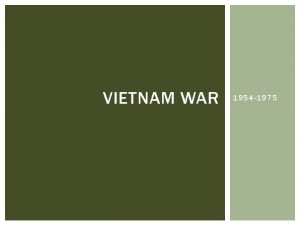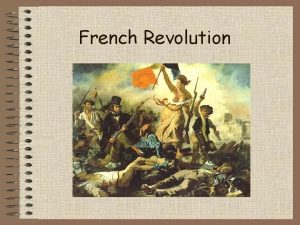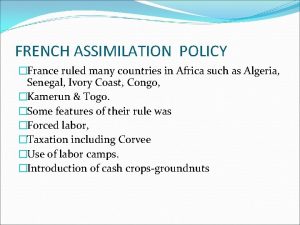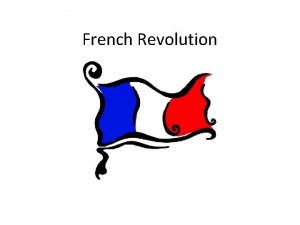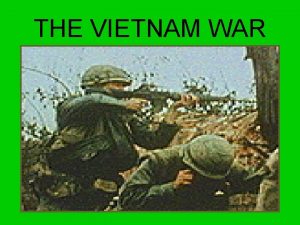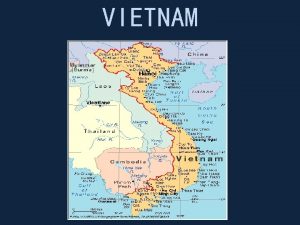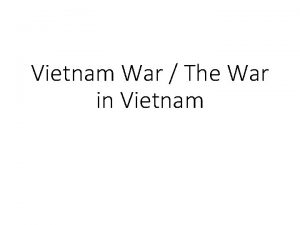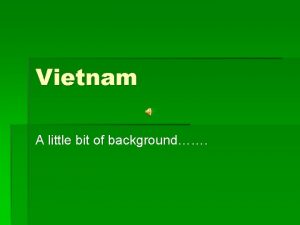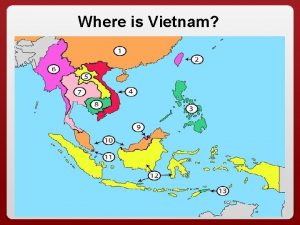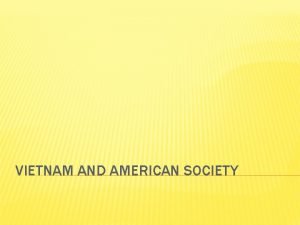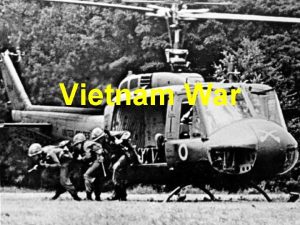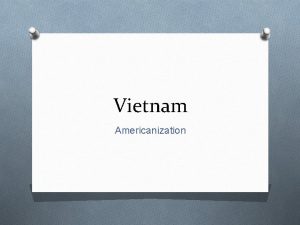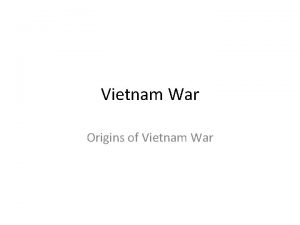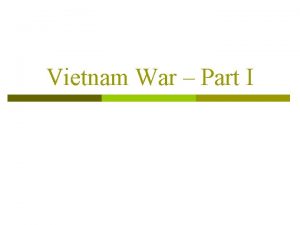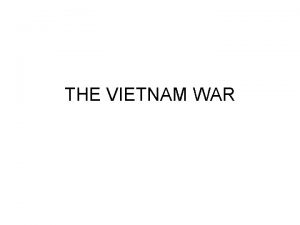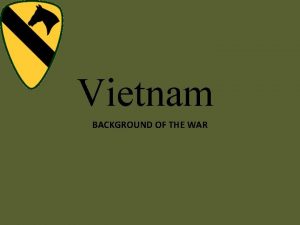The Vietnam Years French Vietnam France ruled most




























- Slides: 28

The Vietnam Years

French > Vietnam France ruled most of Indochina (Vietnam, Laos, and Cambodia) Vietnam peasants get angry at French peasants for farming their land Begin to flee to China and organized under Ho Chi Minh Also tried to restrict rights of Vietnamese (speech and assembly) Created the Indochinese Communist Party and began organizing an independence movement Japan gains control in 1940 Vietminh -> goal to win independence from foreign rule After defeat of Japan in WWII, Ho Chi Minh declares Vietnam an independent nation

France vs. Vietminh France does not want to let go of Vietnam Able to gain most of Southern Vietnam Ho Chi Minh vows to fight from the North to liberate South U. S. involvement begins in 1950 France is reattempting control over Vietnam post WWII Want to strengthen relationship and stop spread of communism Provided economic support to France (nearly $15 mil) Once allies with Vietnam during WWII Fund nearly $1 bil over 4 years

1953 -> Eisenhower becomes President Continues to fund France Explains domino theory -> countries on the brink of communism French unable to retake Vietnam Surrendered in May of 1954 when they lost city at Dien Bien Phu France, Great Britain, Soviet Union, China, U. S. , Laos, and Cambodia meet with Vietminh in Geneva, Switzerland Create the Geneva Accords -> temporarily divided Vietnam along the 17 th parallel Ho Chi Minh gets North and capital city of Hanoi South gets city of Saigon

U. S. Becomes More Involved Begin providing aid to South Vietnam Election to unify country in 1956 Ngo Dinh Diem (S. Vietnam’s Pres. ) refused to take place in election U. S. promises to provide military aid and training to Diem in return for a stable reform gov’t in the South Diem limits opposition of any kind, offered little land distribution to the peasants, and restricted Buddhist practices Vietcong (Communist opposition group) begins attacking Diem gov’t, assassinating thousands of people Ho Chi Minh Trail -> path used to supply weapons and aid to Vietcong from North Vietnam

Kennedy’s Involvement Kennedy administration 1961 Increased financial aid to Diem and sent military advisors to help train S. Vietnamese military Rise of Vietcong attacks forces Diem to enact the hamlet program Moved all villagers to protected areas Many people do not want to move from their homeland buried ancestors Increased attack on Buddhism -> imprisoned and killed them Buddhist monks protest by lighting themselves on fire JFK urges Diem to chill out but he refuses

LBJ’s Involvement Diem and JFK both assassinated Before his death JFK announced intent of removing troops from Vietnam LBJ begins to escalate the war S. Vietnam becomes more unstable 1964 -> Vietnamese patrol boat fires and misses on USS Maddox in Gulf of Tonkin Maddox returns fire and inflicts heavy damage on the patrol boat Days later, reported torpedoes, American destroyers open fire

Alleged attacks prompts LBJ to launch series of bombing raids on N. Vietnam U. S. adopts the Tonkin Gulf Resolution Maddox was in Tonkin to get secret information for secret raids being carried out Granted LBJ broad military powers in Vietnam (did not declare war) Tonkin Gulf Resolution prepared months in advance and LBJ waited for right time to get it pushed through Vietcong attack kills 8 Americans LBJ starts “Operation Rolling Thunder” First sustained bombing of N. Vietnam March of 1965 -> first American combat troops begin arriving in S. Vietnam June of 1965 -> 50 k + U. S. soldiers fighting the Vietcong

U. S. Involvement Escalates

LBJ Increases Involvement of nation supports LBJ in attempting to stop spread of Communism Most Begins dispatching 10 s of thousands of soldiers End of 1965 the U. S. gov’t had sent 180 k + to Vietnam General William Westmoreland keeps requesting troops (Army of the Republic of Vietnam aka ARVN) could not stop the fighting themselves

Fighting in the Jungle terrain + guerilla tactics proves to be difficult to U. S. military Vietcong used hit and run strategy with knowing the terrain better than the U. S. troops Attacked in both cities and countryside (difficult to tell who was a citizen and who was military) Used network of tunnels Punji sticks Peppered land with booby traps and land mines

Plan to defeat Vietcong through attrition -> wearing them down More rebels to dies the quicker the surrender Not the case -> Vietcong receive aid from China and Soviet Union U. S. want to avoid N. Vietnamese gaining support from the S. Vietnam rural population Want to win over citizens = no place for Vietcong to hide? U. S. begins using napalm (gasoline based bombs) and Agent Orange (leaf killing toxic chemical) Search and destroy missions -> finding citizens helping Vietcong and killing their livestock/burning villages

Sinking Morale U. S. morale begins to weaken Corruption in the S. Vietnam gov’t U. S. soldiers begin to turn to drugs Leads to a civil war Many soldiers, however, feel the duty to continue to fight

War at Home Support for the war begins to decrease due to the length Inflation leads to increase in taxes and gov’t spending -> end to the “Great Society”? Vietnam became America’s first “living room war” Credibility gap -> What the LBJ administration reported and the reality

A Nation Divided

Working Class Goes to War Fighting a war in a faraway place + questionable cause = resistance going to Vietnam Begin to look for ways around the draft Medical exemptions, talked in front of lenient draft board, joined National Guard/Coast Guard for exemption from Vietnam service College deferment -> enrollment in a university would suspend draft status Most fighters in Vietnam end up being lower class whites/minorities (working class) 20% of American combat deaths were African Americans (10% of military) Mixed platoons led to racial violence at times 10 K + females serve in Vietnam (mostly as nurses) Red Cross and United Services Organization (hospitality and entertainment)

Roots of Opposition Students begin to become more active in social and political activities Become powerful and vocal group of protestors during Vietnam New Left -> growing youth movement that demanded changes in American society Students for a Democratic Society (SDS) begin to preach that corporations and large gov’t institutions had taken over America Free Speech Movement focused on the American “machine”

Protest Movement SDS organizes march on D. C. LBJ begins requiring college students to be in good academic standing in order to be granted deferment SDS begins encouraging people to skip the draft to Canada or Switzerland Reasons for youth opposition: Belief that U. S. should not be involved in Vietnam’s civil war Argument that U. S. could not police the entire world Morally unjust Returning veterans begin to protest the war Popular music groups -> Peter, Paul, and Mary and Joan Baez #1 song = “Eve of Destruction” by Barry Mc. Guire

Protest vs Resistance “We were having no effect on U. S. policy…. so we thought we had to up the ante. ” Half a million people meet in Central Park to protest Burning draft cards and chanting “Hell, no, we won’t go” Draft resistance began to become common Imprisoned draft dodgers Many people leave the country Group of 30 k+ demonstrators lock arms and march onto the Pentagon steps Met with tear gas and clubs

Divided Nation and LBJ’s Reaction Divided into the doves (opposed war) and hawks (continue war) People begin to think that protests are an act of “disloyalty” “Support our troops” and “America- love it or leave it” LBJ continues his policy of slow escalation His cabinet begins to question his motives Defense Secretary Robert Mc. Namara “It didn’t ad up… What I was trying to find out was how… the war went on year after year when we stopped the infiltration or shrunk it and when we had a very high body count and so on. It just didn’t make sense. ”

1968: An Unforgettable Year

The Tet Offensive Surprise attack by the Vietcong and N. Vietnamese military on many cities Caused many more Americans to turn against the war Jan. 30 th was Vietnamese lunar new year known as “Tet” Truce was agreed on during this week long festival Funerals being held for war victims Coffins carried weapons, many of the villagers were Vietcong Launched an attack on over 100 towns and cities in S. Vietnam and U. S. airbases Carry attack on to the U. S. embassy in Saigon killing 5 Americans Continued for about 1 month before U. S. and S. Vietnamese regain control Tet offensive changes the mindset of many Americans Walter Cronkite (one of most respected journalists) -> “more certain than ever that the bloody experience of Vietnam is to end in a stale mate” New Defense Secretary Clark Clifford claims the war to be “unwinnable”

Loss and Rage Eugene Mc. Carthy pledges to run against LBJ to stop the war in Vietnam LBJ begins to declare the U. S. had changed its Vietnam policy and was seeking a peaceful negotiation to end the war Also announces his withdrawal from the upcoming Presidential election Assassinations of MLK and RFK spark protest and riots Students continue to protest (becoming more aggressive) Violent demonstrations in Chicago during Democratic National Convention paved the way for a Republican Presidential win Nixon vs Hubert Humphrey vs George Wallace Nixon campaigns on a promise to restore law and order and to end the war in Vietnam

End of War and Its Legacy

Nixon and Vietnamization Summer of 1969, Nixon announces first U. S. troops withdrawal Although withdrawing troops, the fighting still continued with N. Vietnam Negotiations to end war were going nowhere U. S and S. Vietnam insist that all N. Vietnam troops from the South and S. Vietnam’s ruler stayed in his position N. Vietnam and Vietcong demand that U. S troops withdraw from S. Vietnam and the S. Vietnam gov’t step aside for a coalition gov’t including Vietcong Nixon confers with National Security Advisor Henry Kissinger Vietnamization -> called for the gradual withdrawal of U. S. troops in order for S. Vietnam to take on a more active combat role in the war Over 3 years U. S. numbers drop from 500 K + to less than 25 K “Peace with honor” Preserve U. S. dignity and negotiation identity Nixon orders secretive bombing raids on countries of Laos and Cambodia (held Vietcong sanctuaries)

Continuing Trouble in the Home Front Nixon appeals to the silent majority -> Americas who quietly supported U. S. efforts in Vietnam My Lai Massacre U. S. troops murdered innocent citizens in My Lai, S. Vietnam Invasion of Cambodia Nixon announces U. S. troops invaded Cambodia to remove N. Vietnamese and Vietcong supply centers 1. 5 mil + students close down 1, 200 + campuses in protests and strikes Kent State University disaster ROTC building burned in protest National Guard brought in and opened fire killing 4 (2 which didn’t participate) Pentagon Papers Document that revealed the U. S. planned to enter the war even though LBJ promised he would not send troops Also revealed no plan of ending the war as long as N. Vietnamese kept fighting

End to the Longest War March of 1972 -> N. Vietnamese launch largest attack on S. Vietnam since Tet offensive Nixon responds by ordering massive bombing campaign and mines be set in N. Vietnam’s largest port N. Vietnam still ok with a stalemate but would not end the war Nixon finally begins taking steps to end America’s involvement in Vietnam Nixon wins reelection Peace talks break down -> Launches “Christmas bombings” Dropped 100 K + bombs over 11 straight days pausing only on X-Mas day March 29, 1973 -> last of U. S. combat troops leave Vietnam Cease fire agreement between North and South Vietnam lasted only months N. Vietnam launches full scale invasion (U. S. sends aid but refuses to send troops) Saigon is captured and S. Vietnam surrenders to N. Vietnam

Vietnam’s Legacy 58 K Americans killed, 303 K wounded North and South Vietnam deaths = 2 mil + Divided U. S. attempted to come to grips with unsuccessful war Troops were not greeted as heroes but received a “cold hand” PTSD, drug use, and suicide become a problem Unveiling of Vietnam Veterans Memorial in D. C. N. Vietnam initially extends welcome to S. Vietnam Then imprison 400 K+ in labor camps U. S. policy changes: Gov’t abolishes the draft Decrease the President’s war-making powers War Powers Act -> must notify Congress within 48 hrs / cannot stay longer than 90 days
 The vietnam war years chapter 22
The vietnam war years chapter 22 Four score and seven years ago is how many years
Four score and seven years ago is how many years Sheep years to human years
Sheep years to human years 300 solar years to lunar years
300 solar years to lunar years Once upon a time there lived a boy
Once upon a time there lived a boy Evidence ruled inadmissible
Evidence ruled inadmissible Napoleon bonaparte dominated
Napoleon bonaparte dominated Egypt social pyramid
Egypt social pyramid How was anglo-saxon britain ruled?
How was anglo-saxon britain ruled? What was life like for jews in greek-ruled lands?
What was life like for jews in greek-ruled lands? How were the lives of egypt's peasants ruled by the seasons
How were the lives of egypt's peasants ruled by the seasons Iq test
Iq test On the eve of world war i, bosnia was ruled by *
On the eve of world war i, bosnia was ruled by * Jacobean era
Jacobean era Old kingdom middle kingdom new kingdom
Old kingdom middle kingdom new kingdom When the moors ruled spain
When the moors ruled spain Chandragupta maurya ruled for _____years.
Chandragupta maurya ruled for _____years. In french in french
In french in french độ dài liên kết
độ dài liên kết Trời xanh đây là của chúng ta thể thơ
Trời xanh đây là của chúng ta thể thơ Voi kéo gỗ như thế nào
Voi kéo gỗ như thế nào Thiếu nhi thế giới liên hoan
Thiếu nhi thế giới liên hoan Fecboak
Fecboak điện thế nghỉ
điện thế nghỉ Một số thể thơ truyền thống
Một số thể thơ truyền thống Thế nào là hệ số cao nhất
Thế nào là hệ số cao nhất Hệ hô hấp
Hệ hô hấp Các số nguyên tố là gì
Các số nguyên tố là gì
